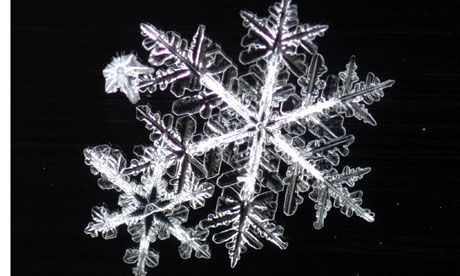“The first snowflakes of the season have arrived for many of us, and what beauties they are. Back in 1611 Johannes Kepler, the German astronomer, tore himself away from the stars for a while and admired snowflakes instead, noticing that almost every snowflake had six sides. He postulated that this was because it was the most efficient way for frozen moisture to pack together.
Despite not knowing about the existence of atoms and molecules, Kepler was thinking along the right lines. We now know that water molecules determine the shape of a snowflake, with the oxygen atoms usually arranging themselves in hexagonal layers. The average snowflake contains as many as 180bn molecules of water.
But not every snowflake has six sides. Thanks to “Snowflake Bentley” (Wilson A Bentley), who lived in Vermont in the US at the turn of the 19th century, we know that snowflakes can take on many shapes. He was the first to photograph a single snowflake crystal, and in his lifetime he took over 5,000 photos of snowflakes, categorising them into 80 types, including needles, columns and a wide variety of hexagonal forms.
As a result of his work, meteorologists were able to show that shape is determined by the weather conditions inside the cloud. Six pointed star snowflakes tend to form in the upper part of clouds, where temperatures are coldest. Lower in the cloud, where it is warmer, columns, needles and hexagonal plates can form too.”
Read more at The Guardian

No comments:
Post a Comment